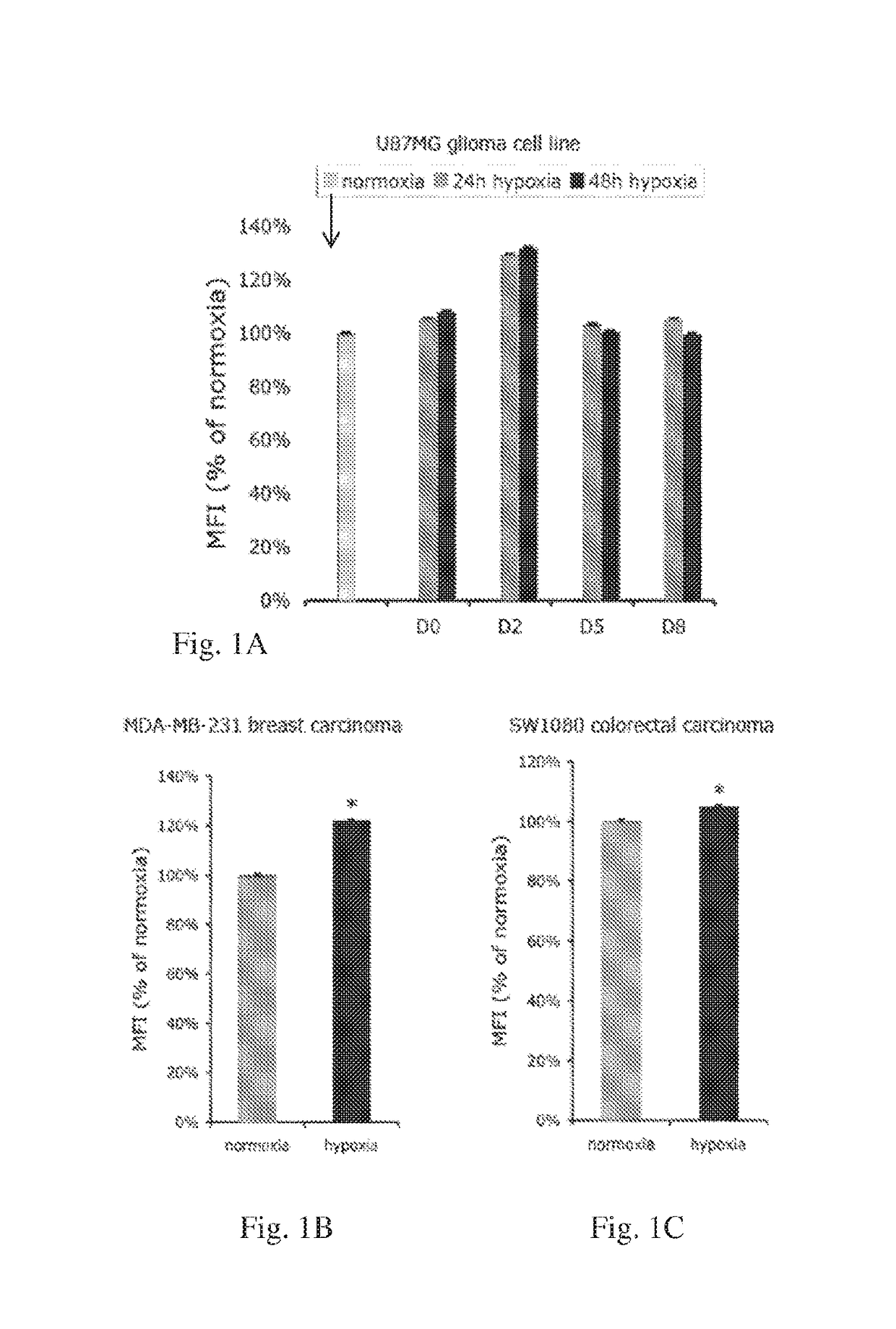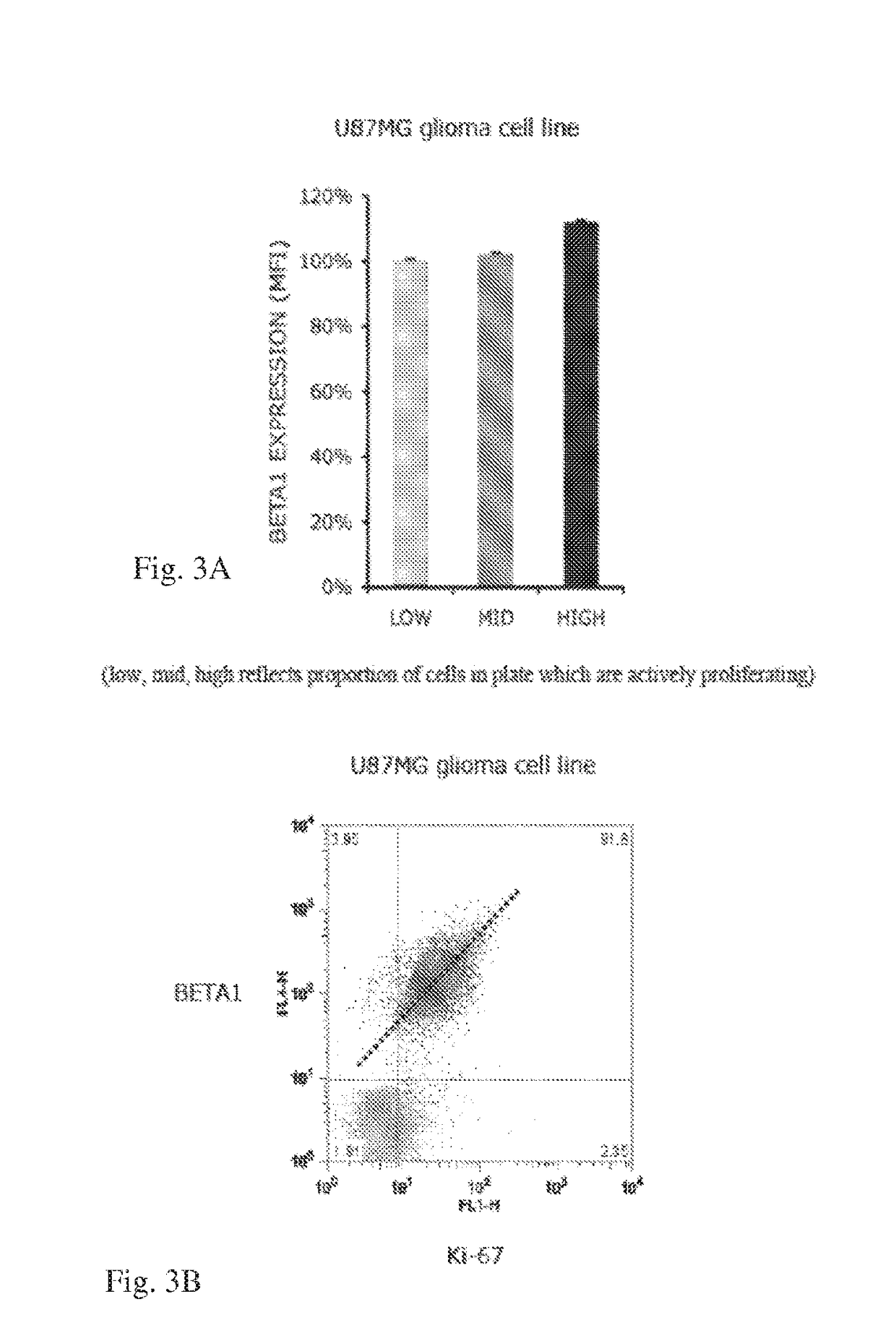Methods and Compositions for Improving Antiangiogenic Therapy with Anti-Integrins
a technology of anti-integrins and compositions, applied in the field of therapeutic compositions and cancer treatment, can solve the problems of not being able to fully inhibit tumors and/or metastases, and the prediction of anti-angiogenesis hypothesis has not yet been realized in the clinic, so as to enhance the delivery of therapeutics and increase vascular permeability
- Summary
- Abstract
- Description
- Claims
- Application Information
AI Technical Summary
Benefits of technology
Problems solved by technology
Method used
Image
Examples
example 1
Hypoxia Associated with High Beta-1 Integrin Expression
[0091]Here it is shown that hypoxia, another common cellular stress in the setting of fast-growing cancers and after antiangiogenic therapy, is correlated with high beta1 expression in patient glioblastomamultiforme (GBM) specimens. To directly confirm this mechanism we subjected glioma cells to 6 to 48 h of 1% oxygen to simulate microenvironmental hypoxia. We observed a significant increase in beta1 integrin expression in glioma cells in vitro (FIG. 1). This is a rapid and reversible cellular response and was also demonstrated in breast and colorectal carcinoma cells. To verify that anti-angiogenic therapy can acutely increase beta1 expression in growing tumors in vivo we stained glioma tumors from mice taken within days of the last bevacizumab treatment. Marked increases in beta1 were observed in the treated tumors compared to controls, particularly in the hypoxic tumor core (FIG. 2).
example 2
Increased Beta 1 Integrin Expression Observed During Tumor Cell Proliferation
[0092]Further increases beta1 expression in tumor cells in vitro were observed during tumor cell proliferation itself. There is an inverse correlation between cell confluence in vitro and level of beta1 in U87MG glioma cells (FIG. 3). In addition, expression of proliferation marker Ki-67 was positively correlated with beta1 expression in U87MG glioma cells as demonstrated by FACS. This is consistent with what others have observed in breast carcinoma cells. Finally, we visually observed significant increases in beta1 integrin expression in angiogenic vessels in human surgical specimens from primary GBM (FIG. 4). This increased beta 1 integrin expression is thought to be related to the association of beta1 to cellular proliferation observed in glioma cells, as discussed above. Thus, in addition to invasion and growth upon vessels, beta1 integrin appears to be intimately involved in tumor cell proliferation, s...
example 3
Beta 1 Integrin Involvement in Anti-VEGF Antibody Resistance in Tumor Cells
[0093]To test the hypothesis that beta1 integrin may be involved in bevacizumab resistance we used immunofluorescenthistochemistry for beta1 integrin in paired patient specimens of GBM taken before bevacizumab therapy and after development of acquired bevacizumabresistance. Clear increases in post-bevacizumab GBM tissues compared to untreated specimens was seen in 9 of 12 pairs (75%, FIG. 5).
[0094]To directly verify the increase in beta1 integrin expression in tumor cells after acquired bevacizumabresistance we analyzed cell lines derived from primary GBMs (first surgery) and from tissue isolated at least 30 d after development of resistance to antiangiogenic therapy. Indeed, beta1 integrin expression was an average of 13-fold higher in cells from the latter group compared to the former (FIG. 6).
[0095]To verify that the observed beta1 integrin upregulation was functional we stained adjacent patient tumor sect...
PUM
| Property | Measurement | Unit |
|---|---|---|
| antibody resistance | aaaaa | aaaaa |
| anti-VEGF resistance | aaaaa | aaaaa |
| size | aaaaa | aaaaa |
Abstract
Description
Claims
Application Information
 Login to view more
Login to view more - R&D Engineer
- R&D Manager
- IP Professional
- Industry Leading Data Capabilities
- Powerful AI technology
- Patent DNA Extraction
Browse by: Latest US Patents, China's latest patents, Technical Efficacy Thesaurus, Application Domain, Technology Topic.
© 2024 PatSnap. All rights reserved.Legal|Privacy policy|Modern Slavery Act Transparency Statement|Sitemap



